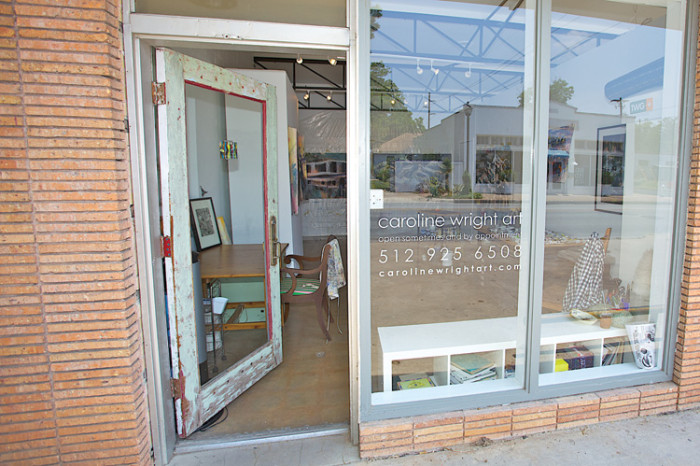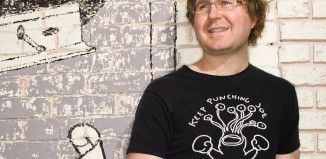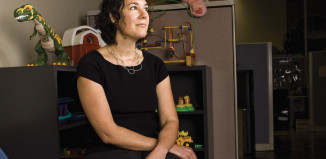Caroline Wright’s studio is quintessentially Austin. The small space is unassuming, with a weatherworn front door and tall windows that let in the afternoon light and a view of the cars, bikes and pedestrians moving their way up and down East Cesar Chavez. The white walls in the sunlight are serene, with Wright’s artwork adding bright punches of color. It’s not ostentatious, and you know you’ve stumbled on something special.
Wright, too, could be said to be quintessentially Austin. An Austin native, she launched her art career in Paris before coming back home to let it take off.
“I had studied abroad in Florence during college, and that made me feel like I reallywanted to live in Europe after school,” she said. “I ended up going to Paris to dog sit for one of my dad’s friends…I’d thought I was going to pursue something fashion-related. I dog sat for her and worked at a clothing store, and I loved being there. It made me want to paint, the way the city is—the light, the beautiful architecture.”

So Wright figured out a way to stay, taking on an internship and looking for a place to have a painting studio. She ended up becoming part of an art collective that repurposed unused space into something culturally relevant. After a brief time in a Jean Paul Gaultier building, she ended up in a collective that was taking over a former ministry of education building that spanned an entire block. The group—which included a radio station, fashion designers and sculptors—knocked down walls and tore up decades-old carpets to make the space their own.
“I was the only American, one of the few English- speaking people, and I was the youngest,” she said. “It was a total adventure. I didn’t have any confidence in myself as a painter; I was just out of college. But I had the space, and these people who were like ‘here, do it.’ That gave me a starting point. The economics of being an artist is something that keeps people from even trying. It’s just so daunting. I thought ‘I need to do something with a commercial outlet; I can’t just paint. And yet I was given this space, for free. Once I sold one painting, I thought ‘OK, someone wants to buy this.’”
As it turns out, a lot of people want to buy her paintings. Now settled into her studio— which she’s had since April of this year—she’s been busy painting, teaching and collaborating. Her art is in the Austonian, Lambert’s and urban-space interiors.
Coming back from Paris, Wright said she was excited about the changes happening in Austin.
 “There’s the side of me, of course, that misses old Austin: it being small and country, going to Barton Springs and having all of 60 people there,” Wright laughed. “But when I moved back to Austin after Paris… there was a burgeoning art community. I hadn’t seen that growing up here. The cosmopolitizing—if that’s a word— of Austin is really exciting. As an artist, to make a living, you have to show your work places. You have to have people who care about it and want to spend money on it. All that’s developed living in a town with nice hotels, restaurants, and businesses engendering that…places like the W, the Austonian—they are specifically selecting local artists and making a point of not importing everything.”
“There’s the side of me, of course, that misses old Austin: it being small and country, going to Barton Springs and having all of 60 people there,” Wright laughed. “But when I moved back to Austin after Paris… there was a burgeoning art community. I hadn’t seen that growing up here. The cosmopolitizing—if that’s a word— of Austin is really exciting. As an artist, to make a living, you have to show your work places. You have to have people who care about it and want to spend money on it. All that’s developed living in a town with nice hotels, restaurants, and businesses engendering that…places like the W, the Austonian—they are specifically selecting local artists and making a point of not importing everything.”
Wright is also a cellist, and music informs much of her work. She will listen to certain music to make certain things happen in her work, she said. The music of jazz pianist Jason Moran inspired an entire body of work she did recently. Dance and nature are also influences, and in 2011 she collaborated with Austin Ballet dancers as part of Califa Arts Collaborative, painting onstage as the audience watched both her projected paintings on rice paper and the dancers.
The future holds a lot of travel for Wright, including a show in Toronto and teaching a workshop in Italy. But having a space of her own in Austin and putting down roots here is one of the most exciting aspects of her recent work.
“I want to be visible to the public,” she said. “I think that’s another part of why Austin is great, that someone like me can afford to have studio space and not be in a closet somewhere in the back room of my house.”
Photography by Kerry Gray Photography
Moving into her own space has been an exciting step for Wright, whose work is featured in some of Austin’s most prominent buildings.
A moving wall gives Wright the ability to open up the space or create more privacy at will.
Wright says she uses painting to slow down and connect to the rhythm underlying life.




































